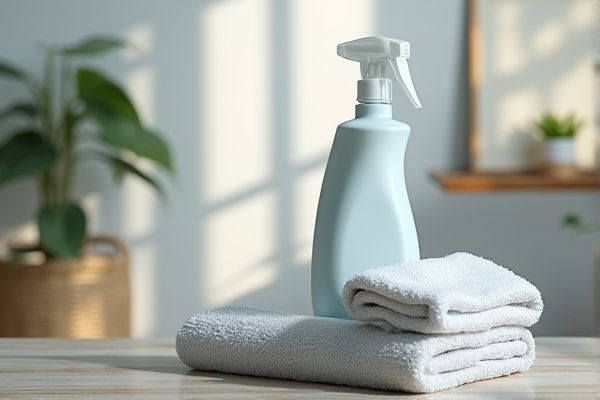
Fabric softener softens clothes and reduces static by coating fibers with conditioning agents, while dryer sheets provide a convenient way to add fragrance and reduce static during the drying cycle without liquid application. Discover the pros, cons, and effective usage tips for both to enhance Your laundry routine in the rest of this article.
Table of Comparison
| Feature | Fabric Softener | Dryer Sheets |
|---|---|---|
| Usage | Added during wash cycle | Added in dryer |
| Function | Softens fabric, reduces static, adds fragrance | Reduces static, softens fabric, adds fragrance |
| Application Type | Liquid or sheet form | Thin, disposable sheets |
| Effect on Fabric | Penetrates fibers, longer-lasting softness | Coats surface of fabric |
| Environmental Impact | May contain chemicals; biodegradable options available | Single-use waste; some biodegradable options |
| Cost | Generally higher per use | Usually lower cost per load |
| Allergy Consideration | May cause skin irritation in sensitive users | May trigger allergies due to fragrance |
| Best For | Deep softening, reducing wrinkles | Quick static reduction, convenient use |
Introduction to Fabric Softeners and Dryer Sheets
Fabric softeners and dryer sheets both serve to reduce static cling and soften fabrics, but they work through different methods: fabric softeners are liquid additives used during the wash cycle, while dryer sheets are added to the dryer for a convenient, residue-free finish. Fabric softeners coat fibers with lubricating chemicals to enhance softness and impart fragrance, whereas dryer sheets contain antistatic agents and softening compounds that activate with heat. Choosing between them depends on your laundry routine and sensitivity to chemicals, as each offers unique benefits tailored to specific fabric care needs.
How Fabric Softeners Work
Fabric softeners work by coating fabric fibers with lubricating chemicals such as quaternary ammonium compounds, which reduce static cling and make fabrics feel softer. These chemicals also help to relax fibers, enhancing the overall softness and reducing wrinkles in clothing. Fabric softeners can be added during the rinse cycle of a washing machine or used in liquid form to maximize fabric care and comfort.
How Dryer Sheets Function
Dryer sheets function by releasing fabric softening agents and lubricants during the drying cycle, which reduce static cling and make clothes feel softer. These sheets also deposit a thin layer of fragrance and anti-wrinkle compounds, enhancing the overall freshness and appearance of garments. Unlike liquid fabric softeners, dryer sheets work through direct contact in the dryer, providing a convenient way to soften fabrics without adding moisture.
Key Differences Between Fabric Softeners and Dryer Sheets
Fabric softeners, available in liquid or sheet form, are designed to be added during the wash cycle to soften fibers and reduce static cling, while dryer sheets are used in the dryer to achieve similar effects by coating fabrics with a thin chemical layer. Fabric softeners often provide long-lasting fragrance and can help maintain fabric flexibility, whereas dryer sheets offer convenience and reduce wrinkles through heat activation. Understanding these key differences helps you choose the best option tailored to your laundry preferences and fabric care needs.
Pros and Cons of Fabric Softeners
Fabric softeners enhance fabric softness and reduce static cling by coating fibers with lubricating chemicals, extending the life of clothing and improving comfort. They may cause buildup on fabrics and washing machines, potentially reducing absorbency and causing irritation to sensitive skin. While fabric softeners provide long-lasting fragrance and softness, they are less eco-friendly due to chemical residues and can sometimes reduce the effectiveness of moisture-wicking fabrics.
Pros and Cons of Dryer Sheets
Dryer sheets offer the advantage of reducing static cling, adding a pleasant scent, and softening fabrics, enhancing your laundry experience. However, they may leave a residue on your dryer lint screen, potentially affecting dryer efficiency, and some individuals with sensitive skin might experience irritation from the synthetic fragrances or chemicals in the sheets. Choosing dryer sheets depends on your priorities for fabric care, scent preferences, and sensitivity to additives in laundry products.
Impact on Laundry Quality
Fabric softeners enhance laundry quality by coating fibers with lubricants that reduce static cling and improve softness, resulting in clothes that feel smoother and smell fresher. Dryer sheets, treated with similar softening agents, offer a quicker and more convenient way to decrease static and add fragrance, but may leave residue on fabrics and dryer components over time. Both products improve fabric texture and smell but differ in application and potential long-term effects on laundry quality.
Environmental Considerations
Fabric softeners often contain chemicals that can contribute to water pollution and may be less biodegradable, impacting aquatic ecosystems negatively. Dryer sheets typically contain synthetic fragrances and plastic-based coatings that can leave microplastic residues in the environment and in household lint. Choosing eco-friendly, biodegradable options or fragrance-free products can reduce environmental harm associated with both fabric softeners and dryer sheets.
Safety and Allergy Concerns
Fabric softeners generally contain fragrance and chemicals that may cause skin irritation or allergic reactions for sensitive individuals. Dryer sheets also release similar additives, but the heat from the dryer can intensify these compounds, potentially exacerbating respiratory issues for people with allergies or asthma. To protect your health, consider using hypoallergenic or fragrance-free options designed specifically to minimize safety and allergy concerns.
Which is Best for You?
Fabric softeners provide long-lasting fragrance and leave clothes feeling softer by coating fibers with conditioning agents, ideal for sensitive skin or frequent laundry users. Dryer sheets offer a convenient, single-use option that reduces static and adds fragrance during drying, suitable for those seeking quick and mess-free laundry care. Your choice depends on whether you prioritize ongoing softness and scent or convenience and ease of use in your laundry routine.
 homyna.com
homyna.com